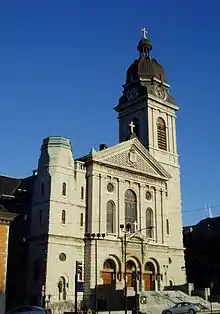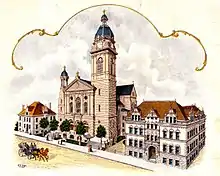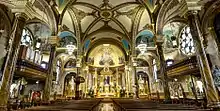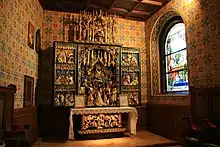St. John Cantius Church (Chicago)
St. John Cantius Church (Polish: Parafia Świętego Jana Kantego) is a historic church of the Roman Catholic Archdiocese of Chicago known for its solemn liturgies and rich program of sacred art and music.
| St. John Cantius Church | |
|---|---|
 The limestone façade of St. John Cantius Church | |
 St. John Cantius Church | |
| Location | 825 North Carpenter Street Chicago |
| Country | United States |
| Denomination | Roman Catholic |
| Website | www.cantius.org |
| History | |
| Founded | 1893 |
| Founder(s) | Congregation of the Resurrection |
| Dedication | St. John Cantius |
| Dedicated | September 4, 1893 |
| Consecrated | December 11, 1898 |
| Architecture | |
| Architect(s) | Adolphus Druiding |
| Style | Baroque |
| Groundbreaking | 1893 |
| Completed | 1898 |
| Construction cost | $130,000 |
| Specifications | |
| Capacity | 2,000 |
| Length | 230 feet (70 m) |
| Width | 107 feet (33 m) |
| Materials | Rusticated Limestone and Brick |
Along with such monumental religious edifices as St. Mary of the Angels, St. Hedwig's or St. Wenceslaus, it is one of the many Polish churches that dominate over the Kennedy Expressway.
The unique baroque interior has remained intact for more than a century and is reminiscent of the sumptuous art and architecture of 18th century Kraków. Of all the Polish Cathedral style churches in Chicago, St. John Cantius stands closest to downtown. The imposing 130 feet (40 m) tower is readily seen from the nearby Kennedy Expressway and is a familiar landmark in Chicago's West Town neighborhood, located at 825 North Carpenter Street.
In 2013, St. John's completed an ambitious restoration, returning the interior to its original splendor.
History
The steady arrival and settlement of Polish immigrants in the area, known as “Expatriate Poland” (Polish: Wygnana Polska), necessitated the foundation of a new parish which would become Saint John Cantius Church. In 1892, these immigrants petitioned the pastor of St. Stanislaus Kostka, the first Polish church in the Archdiocese, for a new church. Fr. Vincent Barzyński of the Congregation of the Resurrection, saw the validity of this request and immediately purchased several lots at Fry and Carpenter Streets for the sum of $75,000.

Designed by Adolphus Druiding, St. John Cantius Church took five years to build. Druiding, drew the plan, and work commenced in the spring of 1893. The cornerstone was laid and blessed in July of that year as 50,000 people attended the ceremony. By December, only the crudely finished basement church was completed. The new parish community held its first Mass in the basement on Christmas Eve.
When the edifice was complete, Archbishop Patrick Feehan performed the Blessing and Dedication ceremonies on December 11, 1898. The parish flourished and reached its peak in 1918 with about 23,000 parishioners and 2,500 children in the school.
The parish retained its Polish character for years, but the building of the Kennedy Expressway which cut through the heart of Chicago's Polonia began a period of decline for the parish as many longtime residents were forced to relocate. The parish was slated for closure as Chicago's inner city neighborhoods declined further through the 1960s and 70s.
A revival of the parish began in the late 1980s by Fr. Frank Phillips, C.R., who became pastor. Fr. Phillips helped to spark a renewal and attract parishioners, as well as financial resources. With improved finances, Fr. Phillips could begin restoring the physical church to its original glory while preserving the many treasures the parish already had. In 1998, with the approval of Francis Cardinal George, O.M.I., Fr. Phillips founded a new religious community of men, the Canons Regular of St. John Cantius, which now staffs the parish.
A gradual gentrification of the surrounding neighborhood has further contributed to the renewal of the parish. The area that was once known as the “Polish Patch,” is now called “River West,” a developing upscale area with fashionable town homes and luxury lofts.
Today, St. John Cantius Church has become the focus of a renaissance of Traditional Catholic rituals and devotions that had fallen out of favor after the Second Vatican Council, such as the Tridentine Mass in Latin as well as Vespers and Benediction, the Corpus Christi procession, the Stations of the Cross, Tenebrae services, and the St. Joseph and St. Anne Novenas. The parish has a rich program of sacred music supported by eight parish choirs and an orchestra.
St. John Cantius Church has witnessed a number of famous visitors from Poland within its walls. In March 1989, the parish hosted a visit by Tadeusz Mazowiecki, Prime Minister of the newly-democratic Poland, while in 1998, Józef Glemp, the Cardinal Primate of Poland came to celebrate a Mass of Thanksgiving and bless the church's new copper cupola. In June 2017, Polish MP Malgorzata Gosiewska visited Saint John Cantius as well as a number of other Polish Churches during an official visit to Chicago.
Although the parish's school has closed, the building now houses the Chicago Academy for the Arts, often called the "Fame" school and compared with New York City's High School of Performing Arts.
In 2016, the church was voted "The Most Beautiful Church in America".[1]
Architecture
The Church building's design is by Adolphus Druiding. Work began on this grandiose structure in the spring of 1893 and was completed by 1898. The building has a façade of rusticated stone in the High Renaissance style which dictated the use of classical elements such as columns, capitals and arches. At the very top is a monumental pediment decorated with the coat of arms of Poland's failed January Uprising, under which is found the inscription "Boże Zbaw Polskę" (God Save Poland in Polish). Just below this on the entablature, is the Latin inscription "Ad maiorem Dei Gloriam", a text which proclaims that this building is for the Greater Glory of God, a Jesuit motto popular in many churches built around the start of the 20th century. Three Romanesque portals set in receding arches lead into the interior. Like St. Michael's, the entrance is flanked by two asymmetrical towers topped with copper cupolas, 200 feet (61 m) and 100 feet (30 m) in height, styled after St. Mary's Basilica in Kraków. The whole structure is 230 feet (70 m) long and 107 feet (33 m) wide and can easily accommodate 2,000 people.

The interior is in the Baroque style. Eight stone columns support the vault. The present decoration is the result of several interior decorations within the first forty years of completion.
The church's main altar, as well as its matching two side altars reputedly originate from the 1893 Columbian Exposition. In 1903 the interior was painted for the first time, and it was at this time that all the plaster and wood ornament were added and the church received the character it has today. The stained glass windows were made by Gawin Co. of Milwaukee, while the interior murals were painted by Lesiewicz around 1920. In addition to religious scenes, such as the Resurrection under the main altar, the artist decorated the side walls with paintings of Polish patron saints.
A new inlaid hardwood floor was installed in St. John Cantius Church in 1997 in a design by Jed Gibbons. Sixteen varieties of wood from around the world were used for the inlaid medallions. The floor is not only a beautiful contemporary work of sacred art but it is also designed as a teaching tool. The medallions inlaid into the main aisle tell the story of salvation: Star of David—Jesus was born as a Jew; Three Crowns—with the arrival of the Three Kings Jesus was made manifest to the world and, in Christian baptism, one is born priest, prophet, and king; Instruments of the Passion—Christ's suffering for our Salvation; Banner—the Resurrection; Star—Christ is the Light of the World. This floor, which is reputedly the only of its kind in the United States, has already won three national awards.

In 2003, work was completed on a replica of the renowned Veit Stoss Altar (Polish: Ołtarz Wita Stwosza) of St. Mary's Basilica in Kraków. Carved by artist Michał Batkiewicz over an eight-year period, this imposing one-third scale copy is the largest and most detailed of work of its kind, and was commissioned as a tribute to the Galician immigrants who founded the parish in 1893. The altar was solemnly dedicated by Józef Glemp, the Cardinal Primate of Poland in August 2003.
A permanent exhibit of sacred art, located in the church's north tower is open on Sundays, as well as on special request. The collection's centerpiece is an elaborate Neapolitan "presepio" (Italian for creche) from Rome. Among St. John Cantius's many other treasures are a nineteenth-century copy of the icon of Our Lady of Częstochowa adorned with jeweled crowns personally blessed by Pope John Paul II; a reproduction of the famous miraculous crucifix from Limpus, Portugal, a nineteenth-century Pietà from Bavaria, Germany, a hand written altar missal on display, as well as several hundred authenticated relics of saints.
St. John Cantius in literature and film
St. John Cantius was featured in two films that were both shot in the summer and fall of 1990. The first was a made-for-television movie, entitled Johnny Ryan. The second was a major Hollywood film entitled, Only the Lonely, directed by John Hughes and starring Maureen O'Hara and John Candy.
St. John Cantius also serves as the backdrop for Steffi Rostenkowski's great realization in Nelson Algren's work Never Come Morning where, night after night, she heard the iron rocking of the bells of Saint John Cantius. Each night they came nearer till the roar of The Loop was only a troubled whimper beneath the rocking of the bells. "Everyone lives in the same big room", she would tell herself, as they rocked. "But nobody's speakin' to anyone else, an' nobody got a key".[2]
St. John Cantius in architecture books
St. John Cantius is featured in a number of books on Chicago architecture, most notably The AIA Guide to Chicago by Alice Sinkevitch (Harvest Books 2004). St. John Cantius is found in a number of books on church architecture, among them Heavenly City: The Architectural Tradition of Catholic Chicago by Denis R. McNamara (Liturgy Training Publications 2005), Chicago Churches and Synagogues: An Architectural Pilgrimage by George A. Lane (Loyola Press 1982), Chicago Churches: A Photographic Essay by Elizabeth Johnson (Uppercase Books Inc, 1999), and The Archdiocese of Chicago: A Journey of Faith by Edward R. Kantowicz (Booklink 2007).
References
- Pashman, Manya Brachear (April 20, 2016). "St. John Cantius chosen America's Most Beautiful Church". Chicago Tribune.
- Holden, Greg (March 1, 2001). Literary Chicago: A Book Lover's Tour of the Windy City. Lake Claremont Press. p. 130. ISBN 978-1893121010.
External links
![]() Media related to St. John Cantius Church (Chicago) at Wikimedia Commons
Media related to St. John Cantius Church (Chicago) at Wikimedia Commons
